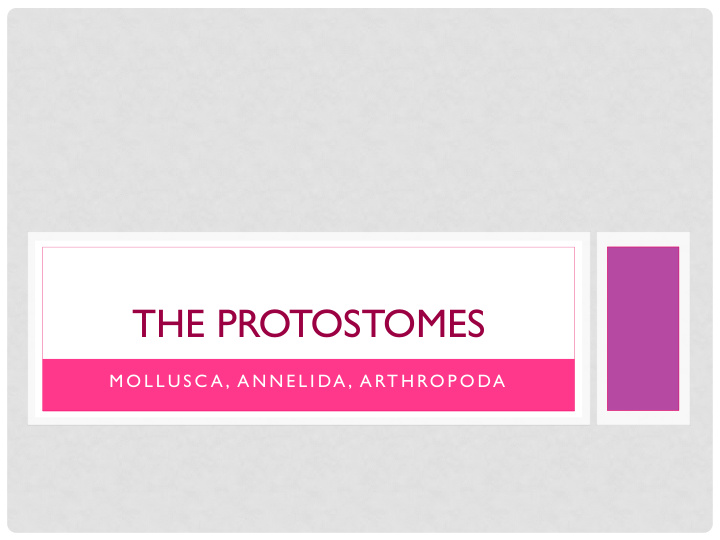



THE PROTOSTOMES M O L L U S C A , A N N E L I DA , A RT H RO P O DA
Radiata Bilateria Eumetazoa Parazoa no true tissues Multicellularity
DEUTEROSTOMES PROTOSTOMES “mouth second” “mouth first”
COMMON FEATURES Features Mollusca Annelida Arthropoda # of germ triploblasts layers type of bilaterally-symmetric symmetry body cavity coelom present fate of mouth develops first blastopore type of digestive complete digestive system system
DISTINGUISHING FEATURES Features Mollusca Annelida Arthropoda annellus arthron + podos Etymology molluscus, “soft” “little ring” “joint foot” segmented soft-bodied body, tough General animals with an soft, segmented exoskeleton, external or worms description jointed internal shell appendages ~750,000 sp. # of species ~100,000 spp. ~15,000 sp. (highest sp. diversity)
MOLLUSK BODY PLAN • muscular foot • mantle • calcium carbonate shell • visceral mass http://www.bio.miami.edu/dana/pix/ham.jpg, http://kentsimmons.uwinnipeg.ca/16cm05/1116/33-21-ClamAnatomy-L.jpg, , http://images.encarta.msn.com/xrefmedia/aencmed/targets/illus/ilt/T010708A.gif
ANNELID BODY PLAN • metameres or segments • septa • setae or chaetae • sense organs
ARTHROPOD BODY PLAN • body segments • exoskeleton of protein + chitin • appendages that extend from the body wall
Phylum Mollusca (L. molluscus , “soft”) Feeding • herbivores, carnivores, filter feeders, detritivores, parasites • filter feeders: incurrent/excurrent siphon, mucus & cilia on gills • radula Respiration • aquatic: gills inside mantle cavity • terrestrial: constantly moist & highly vascularized mantle cavity Circulation • open circulatory system (snails, clams): sinus • closed circulatory system (squid, octopuses) Excretion • nephridia Response • simple nervous system (bivalves) • highly-developed nervous system (squid, octopuses) Movement • foot + mucus (snails) • jet propulsion (octopuses) Reproduction • external fertilization (snails, bivalves) • internal fertilization (cephalopods, some snails) • hermaphroditic, cross-fertilization • trochophore larvae
Phylum Mollusca Gastropoda snails and slugs octopuses,squids, Cephalopoda cuttlefish, N autilus clams, oysters, mussels, Bivalvia scallops Scaphopoda tusk shells Aplacophora, Monoplacophora, chiton Polyplacophora
Feeding • herbivores, carnivores, filter feeders, detritivores, parasites • filter feeders: incurrent/excurrent siphon, mucus & cilia on gills in bivalves • radula in gastropods • jaws in cephalopods
Respiration • aquatic: gills inside mantle cavity • terrestrial: constantly moist & highly vascularized lung in mantle cavity
Circulation • open circulatory system (snails, clams): sinus • closed circulatory system (squid, octopuses) http://chsweb.lr.k12.nj.us/mstanley/outlines/circulation/Circulation_files/image013.gif
Excretion • nephridia
Response • simple nervous system (bivalves) • highly-developed nervous system (squid, octopuses) http://classconnection.s3.amazonaws.com/754/flashcards/566754/png/49.21320629922544.png
Movement • foot + mucus (snails) • jet propulsion (octopuses)
Reproduction • external fertilization (snails, bivalves) • internal fertilization (cephalopods, some snails) • hermaphroditic, cross-fertilization • trochophore larvae
Phylum Annelida (L. annellus , “ring”) Feeding • herbivores, carnivores, detritivores • pharynx Respiration • aquatic: through gills in their chaetae • terrestrial: diffusion through moist skin Circulation • closed circulatory system (blood vessels and multiple hearts) Excretion • nephridia in each segment Response • highly-developed nervous system Movement • terrestrial: contraction of longitudinal and circular muscles against the hydrostatic skeleton • aquatic: paddling of the parapodia Reproduction • asexual: fragmentation, budding in aquatic forms • some hermaphroditic, cross-fertilization • internal fertilization in most • trochophore larvae in marine forms • eggs in cocoons in terrestrial forms
Respiration • aquatic: through gills in their chaetae • terrestrial: diffusion through moist skin
Circulation • closed circulatory system (blood vessels and multiple hearts)
Reproduction • asexual: fragmentation, budding in aquatic forms • some hermaphroditic, cross-fertilization • internal fertilization in most • trochophore larvae in marine forms • eggs in cocoons in terrestrial forms
Phylum Annelida Oligochaeta earthworms, Tubifex bristle worms, Polychaeta sandworm, clamworm Hirudinea leeches
Phylum Arthropoda (G. arthron + podos , “joint foot ”) Feeding • herbivores, carnivores, omnivores, bloodsuckers, filter feeders, detritivores, parasites • fangs, proboscis, sickle-shaped jaws, pincers Respiration • terrestrial: spiracles and tracheal tubes or book lungs in spiders • aquatic: feather-like gills in lobsters, crabs and book gills in horseshoe crabs Circulation • open circulatory system (heart blood vessels sinuses heart) Excretion • aquatic: diffusion • terrestrial: Malpighian tubules Response • highly-developed nervous system with brain, nerve cords, ganglia, and sense organs Movement • well-developed muscle groups • exoskeleton Reproduction • aquatic: internal/external fertilization • terrestrial: internal fertilization •
Phylum Arthropoda crabs, crayfish, lobsters, Crustaceans barnacles, shrimps horseshoe crab, ticks, Chelicerates spiders, mites, scorpions centipedes, millipedes, Uniramia insects Trilobita trilobites (extinct)
Feeding • herbivores, carnivores, omnivores, bloodsuckers, filter feeders, detritivores, parasites • fangs, proboscis, sickle-shaped jaws, pincers
Respiration • terrestrial: spiracles and tracheal tubes or book lungs in spiders • aquatic: feather-like gills in lobsters, crabs and book gills in horseshoe crabs
Circulation • open circulatory system (heart blood vessels sinuses heart)
Excretion • aquatic: diffusion • terrestrial: Malpighian tubules
Response • highly-developed nervous system with brain, nerve cords, ganglia, and sense organs
• 2 pairs of antennae, • pair of mandibles • pair of compound eyes • pair of many-branched appendages per segment http://www.arthursclipart.org/biologya/biology/crustaceans%204.gif
• Pair of chelicerae
• Single-branching appendages • 2 pairs per segment in millipedes • 1 pair per segment in centipedes • Pair of antennae • Mandibles and maxillae • *insects are the only invertebrates to have developed flight
Recommend
More recommend